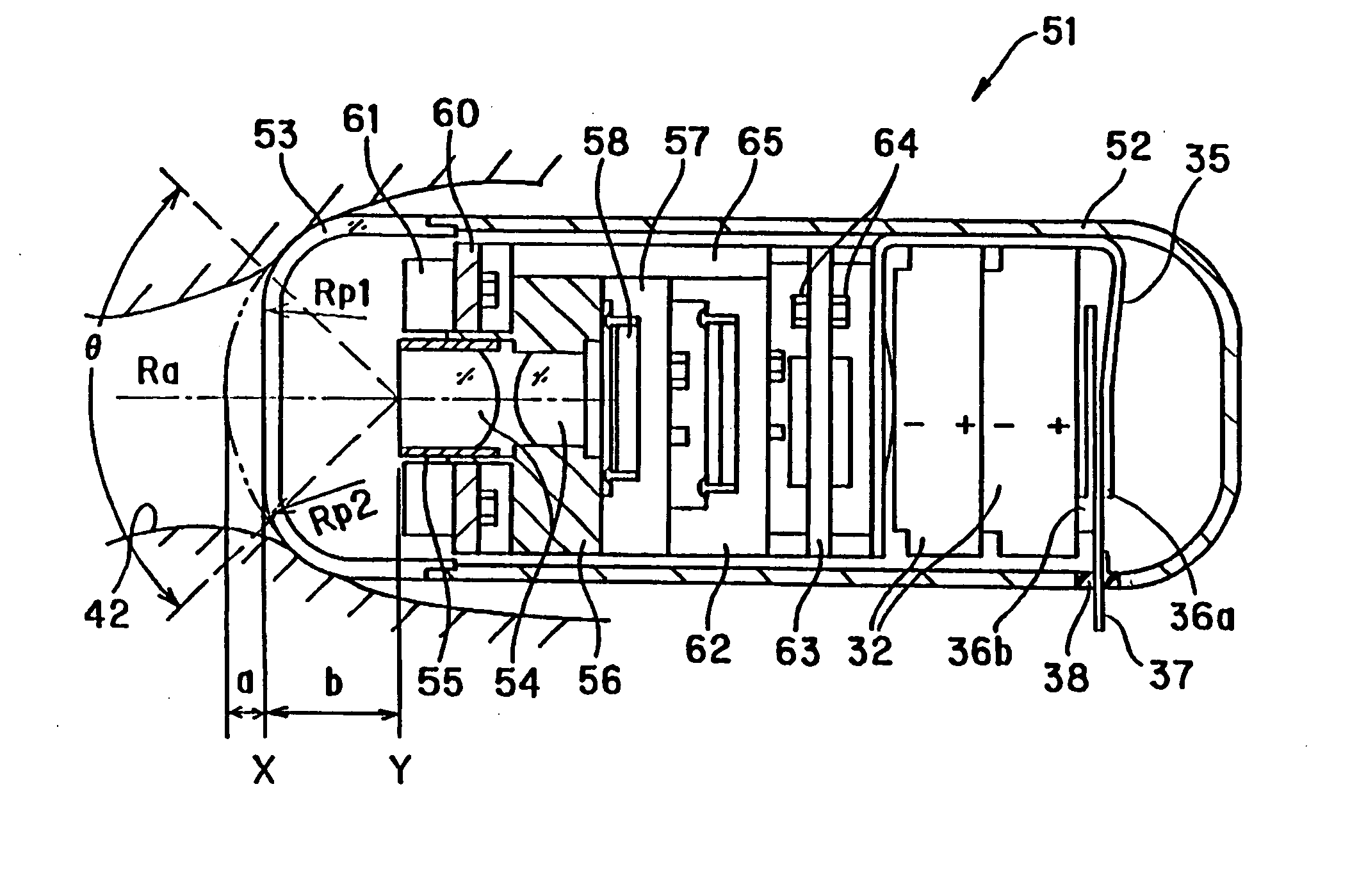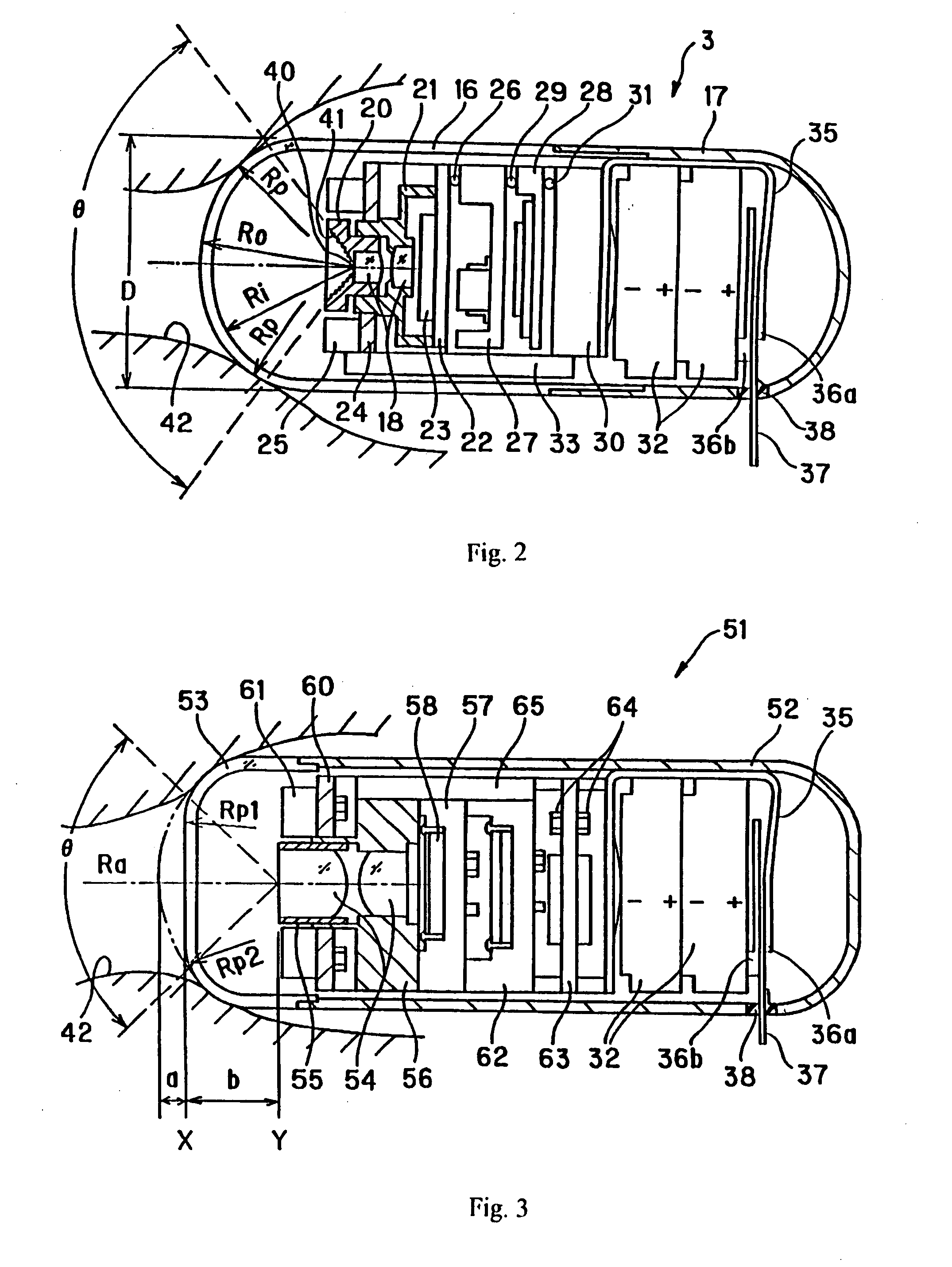Capsule endoscope
a capsule and endoscope technology, applied in the field of endoscopes, can solve the problems of difficult swallowing of capsules, excessive outer diameter of capsules, and obstruction of the central region's view field, and achieve the effect of improving the ease of swallowing and ensuring the observation field
- Summary
- Abstract
- Description
- Claims
- Application Information
AI Technical Summary
Benefits of technology
Problems solved by technology
Method used
Image
Examples
embodiment 1
[0016] Embodiment 1 will be described with reference to FIGS. 1(A), 1(B) and 2. FIGS. 1(A) and 1(B) show the capsule endoscope system, with FIG. 2 being a cross-sectional view showing the internal configuration of the capsule endoscope according to this embodiment. As shown in FIG. 1(A), a capsule endoscope apparatus 1 which is equipped with the first embodiment for performing endoscopic examinations uses a capsule endoscope 3 which wirelessly transmits image signals of the internal walls of the tubes in a coelom while passing through such a tube after being swallowed by a patient 2. An external unit 5 (one that is placed outside the patient's body) receives radio signals transmitted by this capsule endoscope 3 through an antenna unit 4 and stores the images.
[0017] In this external unit 5, a memory unit such as a compact flash memory of 1 gigabyte capacity, for example, is used to store the image data. The external unit 5 can then be connected to a display system 6 (FIG. 1(B)) in o...
embodiment 2
[0026]FIG. 3 is a cross-sectional view showing the internal configuration of a capsule endoscope 51 according to Embodiment 2 of the invention. In the capsule endoscope 51, a transparent front cover 53 is fitted and glued to the front end of a member 52 which has a cylindrical shape. The rear end of the capsule endoscope 51 is closed using a rounded shape, making the interior of the capsule endoscope 51 watertight. An objective optical system 54 is provided within the capsule endoscope. Behind a central region of the transparent cover 53, the objective optical system 54 is formed by attaching a first lens to the first lens frame 55 and a second lens to a second lens frame 56, respectively. At the image plane, a CMOS image sensor 58 is installed on a planar surface that forms the lower surface of a two-level recessed portion at a front surface of a circuit board 57. Nearer the front of the capsule, a circuit board 60 is matched and glued to a cylindrical section of the second lens fr...
embodiment 3
[0029]FIG. 4 is a cross-sectional view showing the internal configuration of a capsule endoscope according to Embodiment 3 of the invention. In the capsule endoscope 71 shown in FIG. 4, a transparent cover 73 that includes a hemispheric-shaped front end is water-tightly fixed to the open end section of a rear case 72 which has a cylindrical shape. The rear case 72 has its other end closed by a rounded shape.
[0030] The following components are contained within the capsule endoscope 71. At an axial position facing the transparent cover 73, there is an objective optical system 76 which is attached to a lens frame 75. At the image surface of the objective optical system 76 is placed a CMOS image sensor 78 which is protected by a cover glass 77. This CMOS image sensor 78 is mounted to the front surface of a circuit board 79. Of course, instead of a CMOS image sensor 78, a CCD image sensor can instead be used.
[0031] The objective optical system 76 consists of two plano-convex lens eleme...
PUM
 Login to View More
Login to View More Abstract
Description
Claims
Application Information
 Login to View More
Login to View More - R&D
- Intellectual Property
- Life Sciences
- Materials
- Tech Scout
- Unparalleled Data Quality
- Higher Quality Content
- 60% Fewer Hallucinations
Browse by: Latest US Patents, China's latest patents, Technical Efficacy Thesaurus, Application Domain, Technology Topic, Popular Technical Reports.
© 2025 PatSnap. All rights reserved.Legal|Privacy policy|Modern Slavery Act Transparency Statement|Sitemap|About US| Contact US: help@patsnap.com



